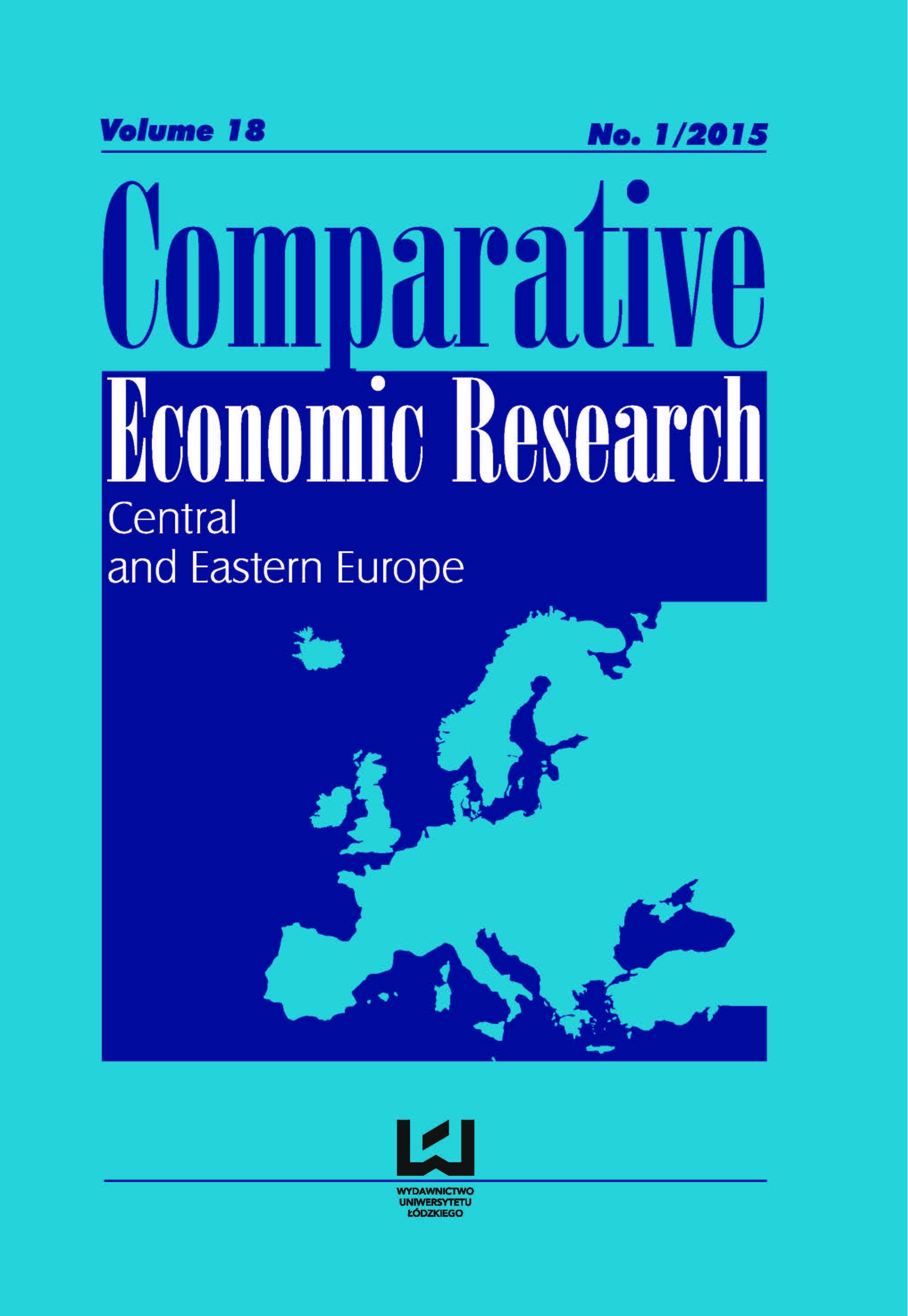Modelling Of Eco-innovation Diffusion: The EU Eco-label
DOI:
https://doi.org/10.1515/cer-2015-0004Keywords:
eco-labe, eco-innovation, innovation diffusion, Bass modelAbstract
The aim of this article is to carry out a theoretical and empirical analysis of the process of eco-label diffusion. Eco-labels allow consumers to identify products and services that have a reduced environmental impact during their life cycle. Thus, they are aimed at diminishing the information gap between sellers and buyers. The results of the estimation using the Bass model indicate that the diffusion of the EU eco-label has been most dynamic in countries such as Hungary, Poland, Denmark, Germany and France. In turn, the scope of diffusion (absolute saturation level) reached the highest value for companies in France and Italy. In addition, the results of the study confirm the stimulating impact of the scope of eco-label diffusion on consumer awareness of environmental issues. This finding points to the need for environmental education among consumers, which could in turn encourage firms to undertake pro-environmental actions.
Downloads
References
Attitudes of European citizens towards the environment. ec.europa.eu/public_opinion/archives/ebs/ebs_365_pres_en.pdf (05.05.2014).
Google Scholar
Attitudes of European entrepreneurs towards eco-innovation. Analytical report. (05.05.2014).
Google Scholar
Bass F.M. (1969), A New Product Growth Model for Consumer Durables, ‘Management Science’, vol. 15. doi: 10.1287/mnsc.15.5.215
Google Scholar
Cainelli G., Mazzanti M., Zoboli, R. (2011), Environmental innovations, complementarity and local/global cooperation: evidence from North-East Italian industry, ‘International Journal of Technology, Policy and Management’, vol. 11, no. ¾.
Google Scholar
Crespi J.M., Marette S. (2005), Eco-Labelling Economics: Is Public Involvement Necessary, [in:] Krarup S., Russell C.S. (eds) Environment, Information and Consumer Behaviour, Edward Elgar, Cheltenham.
Google Scholar
Eco-innovation in France. www.eco-innovation.eu/France (17.04.2014).
Google Scholar
Eco-innovation in Hungary. www.eco-innovation.eu/Hungary (17.04.2014).
Google Scholar
Eco-innovation in Italy. www.eco-innovation.eu/Italy (17.04.2014).
Google Scholar
Eco-innovation in Poland. www.eco-innovation.eu/Poland (17.04.2014).
Google Scholar
Griliches Z. (1957), Hybrid Corn: An Exploration of the Economics of Technological Change, ‘Econometrica’, vol. 25. doi: 10.2307/1905380
Google Scholar
Hall B. (2004), Innovation and Diffusion, NBER, Cambridge.
Google Scholar
Horne R.E. (2009), Limits to labels: The role of eco-labels in the assessment of product sustainability and routes to sustainable consumption, ‘International Journal of Consumer Studies’, vol. 33.
Google Scholar
ISO (1999), Environmental Labels and Declarations – Self-declared Environmental Claims (Type II Environmental Labelling) (ISO 14021: 1999), Own Publication, Geneva.
Google Scholar
ISO (2000), Environmental Labels and Declarations – Type I Environmental Labelling – Principles and Procedures (ISO 14024: 1999), Own Publication, Geneva.
Google Scholar
ISO (2007), Environmental Labels and Declarations – Type III Environmental Declarations–Principles and Procedures (ISO 14025: 2007), Own Publication, Geneva.
Google Scholar
Katz E., Levin M.L., Hamilton H. (1963), Traditions of research on the diffusion of innovation, ‘American Sociological Review’, vol. 28, no. 2. doi: 10.2307/2090611
Google Scholar
Kemp R., Pearson P., Measuring eco-innovation, European Commission, Brussels 2008.
Google Scholar
Kenzo A., Higashida K., Ishikawa J. (2002), Eco-labelling, Environment, and International Trade, [in:] Robert Stern (ed.) Issues and Options for U.S.-Japan Trade Policies, Ann Arbour: University of Michigan Press, Michigan.
Google Scholar
Kijek A., Kijek T. (2010), Modelling of innovation diffusion, ‘Operations Research and Decisions’, no. ¾.
Google Scholar
Mahajan V., Muller E., Bass, F.M. (1990), New product diffusion models in marketing: A review and directions for research, ‘Journal of Marketing’, vol. 54, no. 1. doi: 10.2307/1252170
Google Scholar
Mansfield E. (1971) Technological Change: An Introduction to a Vital Area of Modern Economics, W.W. Norton & Company Inc., New York.
Google Scholar
Mehamli A. (2013), Determinants of Environmental Product Innovation in the Detergent and Maintenance Sector: Application for the European Ecolabel Certification, ‘International Business Research’, vol. 6, no. 2.
Google Scholar
OECD (1991), Environmental Labelling in OECD Countries, OECD Publishing, Paris.
Google Scholar
OECD (2009), Sustainable Manufacturing and Eco-Innovation. Framework, Practices and Measurement, OECD Publishing, Paris.
Google Scholar
OECD (2010), Consumer Policy Toolkit, OECD Publishing, Paris.
Google Scholar
OECD (2011), Fostering Innovation for Green Growth, OECD Publishing, Paris.
Google Scholar
Ottman J., Stafford E., Hartman C. (2006), Avoiding green marketing myopia: ways to improve consumer appeal for environmentally preferable products, ‘Environment’, vol. 48, no. 5.
Google Scholar
Piotrowski R., Kratz S. (1999), Eco-Labelling in the Globalised Economy, ‘International Politics and Society’, vol. 4.
Google Scholar
Popp D., Newell R.G., Jaffe A.B. (2010), Energy, the environment, and technological change, [in:] Bronwyn Hall and Nathan Rosenberg (eds) Handbook of the Economics of Innovation, North-Holland, Amsterdam.
Google Scholar
Rennings K. (2000) Redefining innovation — eco-innovation research and the contribution from ecological economics, ‘Ecological Economics’, vol. 32, issue 2. doi: 10.1016/S0921-8009(99)00112-3
Google Scholar
Rogers E.M. (2003), Diffusion of Innovations, The Free Press, New York.
Google Scholar
Ryan B., Gross N. (1943), The Diffusion of Hybrid Seed Corn in two Iowa Communities, ‘Rural Sociology’, vol. 8.
Google Scholar
Srinivasan V., Mason C.H. (1986), Nonlinear least squares estimation of new product diffusion models, ‘Marketing Science’, vol. 5. doi: 10.1287/mksc.5.2.169
Google Scholar
Stoneman P. (2002), The Economics of Technological Diffusion, Blackwell, Oxford.
Google Scholar
Stoneman P., Battisti G. (2010), The diffusion of new technology, [in:] Hall B.H., Rosenberg N. (eds), Handbook of the Economics of Innovation, Amsterdam, Elsevier.
Google Scholar
Stoneman P., Diederen P. (1994), Technology Diffusion and Public Policy, ‘Economic Journal’, vol. 104, no. 425. doi: 10.2307/2234987
Google Scholar
USEPA (1993), Status Report on the Use of Environmental Labels Worldwide, Office of Pollution Prevention and Toxics, Washington.
Google Scholar
Wysokińska Z. (2013), Transition To A Green Economy In The Context Of Selected European And Global Requirements For Sustainable Development, ‘Comparative Economic Research’, vol.16, issue 4.
Google Scholar
Zhang T., Gensler S., Garcia R. (2011), A Study of the Diffusion of Alternative Fuel Vehicles: An Agent-Based Modeling Approach, ‘Journal of Product Innovation Management’, vol. 28.
Google Scholar
Karakaya E., Hidalgo A. Nuur C. (2014), Diffusion of eco-innovations: A review, ‘Renewable and Sustainable Energy Reviews’, vol. 33.
Google Scholar
Downloads
Published
How to Cite
Issue
Section
License

This work is licensed under a Creative Commons Attribution-NonCommercial-NoDerivatives 4.0 International License.











